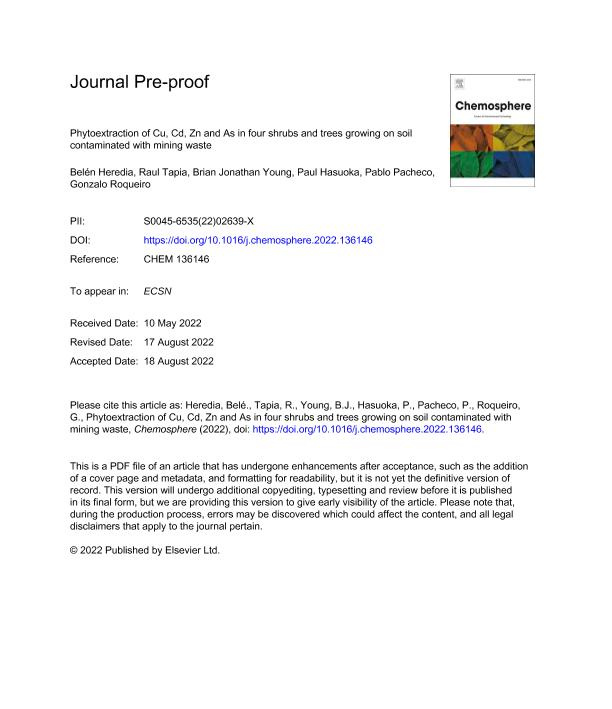Mostrar el registro sencillo del ítem
dc.contributor.author
Heredia, Tatiana Belén

dc.contributor.author
Tapia Balmaceda, Raúl Esteban

dc.contributor.author
Young, Brian Jonathan

dc.contributor.author
Hasuoka, Paul Emir

dc.contributor.author
Pacheco, Pablo Hugo

dc.contributor.author
Roqueiro, Gonzalo

dc.date.available
2024-01-15T15:59:48Z
dc.date.issued
2022-08
dc.identifier.citation
Heredia, Tatiana Belén; Tapia Balmaceda, Raúl Esteban; Young, Brian Jonathan; Hasuoka, Paul Emir; Pacheco, Pablo Hugo; et al.; Phytoextraction of Cu, Cd, Zn and As in four shrubs and trees growing on soil contaminated with mining waste; Pergamon-Elsevier Science Ltd; Chemosphere; 308; 8-2022; 1-40
dc.identifier.issn
0045-6535
dc.identifier.uri
http://hdl.handle.net/11336/223639
dc.description.abstract
Mining activity has degraded large extensions of soil and its waste is composed of metals, anthropogenic chemicals, and sterile rocks. The use of native species in the recovery of polluted soils improves the conditions for the emergence of other species, tending to a process of ecosystem restoration. The objective of this study was to evaluate the bioaccumulation of metal(loid)s in four species of native plants and the effect of their distribution and bioavailability in soil with waste from an abandoned gold mine. Soil samples were taken from two sites in La Planta, San Juan, Argentina: Site 1 and Site 2 (mining waste and reference soil, respectively). In Site 1, vegetative organ samples were taken from Larrea cuneifolia, Bulnesia retama, Plectrocarpa tetracantha, and Prosopis flexuosa. The concentration of metal(loid)s in soil from Site 1 were Zn > As > Cu > Cd, reaching values of 7123, 6516, 240 and 76 mg kg−1, respectively. The contamination indices were among the highest categories of contamination for all four metal(loid)s. The spatial interpolation analysis showed the effect of the vegetation as the lowest concentration of metal(loid)s were found in rhizospheric soil. The maximum concentrations of As, Cu, Cd and Zn found in vegetative organs were 371, 461, 28, and 1331 mg kg−1, respectively. L. cuneifolia and B. retama presented high concentrations of Cu and Zn. The most concentrated metal(loid)s in P. tetracantha and P. flexuosa were Zn, As and Cu. Cd was the least concentrated metal in all four species. The values of BAF and TF were greater than one for all four species. In conclusion, the different phytoextraction capacities and the adaptations to arid environments of these four species are an advantage for future phytoremediation strategies. Their application contributes to the ecological restoration and risk reduction, allowing the recovery of ecosystem services.
dc.format
application/pdf
dc.language.iso
eng
dc.publisher
Pergamon-Elsevier Science Ltd

dc.rights
info:eu-repo/semantics/openAccess
dc.rights.uri
https://creativecommons.org/licenses/by/2.5/ar/
dc.subject
ABANDONED MINE
dc.subject
BIOACCUMULATION
dc.subject
BIOAVAILABILITY
dc.subject
METAL
dc.subject
PHYTOREMEDIATION
dc.subject
SOIL POLLUTION
dc.subject.classification
Ciencias Medioambientales

dc.subject.classification
Ciencias de la Tierra y relacionadas con el Medio Ambiente

dc.subject.classification
CIENCIAS NATURALES Y EXACTAS

dc.title
Phytoextraction of Cu, Cd, Zn and As in four shrubs and trees growing on soil contaminated with mining waste
dc.type
info:eu-repo/semantics/article
dc.type
info:ar-repo/semantics/artículo
dc.type
info:eu-repo/semantics/publishedVersion
dc.date.updated
2024-01-12T15:33:28Z
dc.journal.volume
308
dc.journal.pagination
1-40
dc.journal.pais
Estados Unidos

dc.description.fil
Fil: Heredia, Tatiana Belén. Instituto Nacional de Tecnología Agropecuaria. Centro Regional Mendoza - San Juan. Estación Experimental Agropecuaria San Juan; Argentina. Consejo Nacional de Investigaciones Científicas y Técnicas. Centro Científico Tecnológico Conicet - Mendoza; Argentina
dc.description.fil
Fil: Tapia Balmaceda, Raúl Esteban. Instituto Nacional de Tecnología Agropecuaria. Centro Regional Mendoza - San Juan. Estación Experimental Agropecuaria San Juan; Argentina. Consejo Nacional de Investigaciones Científicas y Técnicas. Centro Científico Tecnológico Conicet - Mendoza; Argentina
dc.description.fil
Fil: Young, Brian Jonathan. Instituto Nacional de Tecnología Agropecuaria. Centro de Investigación en Ciencias Veterinarias y Agronómicas. Instituto de Microbiología y Zoología Agrícola; Argentina
dc.description.fil
Fil: Hasuoka, Paul Emir. Consejo Nacional de Investigaciones Científicas y Técnicas. Centro Científico Tecnológico Conicet - San Luis. Instituto de Química de San Luis. Universidad Nacional de San Luis. Facultad de Química, Bioquímica y Farmacia. Instituto de Química de San Luis; Argentina
dc.description.fil
Fil: Pacheco, Pablo Hugo. Consejo Nacional de Investigaciones Científicas y Técnicas. Centro Científico Tecnológico Conicet - San Luis. Instituto de Química de San Luis. Universidad Nacional de San Luis. Facultad de Química, Bioquímica y Farmacia. Instituto de Química de San Luis; Argentina
dc.description.fil
Fil: Roqueiro, Gonzalo. Instituto Nacional de Tecnología Agropecuaria. Centro Regional Mendoza - San Juan. Estación Experimental Agropecuaria San Juan; Argentina
dc.journal.title
Chemosphere

dc.relation.alternativeid
info:eu-repo/semantics/altIdentifier/url/https://linkinghub.elsevier.com/retrieve/pii/S004565352202639X
dc.relation.alternativeid
info:eu-repo/semantics/altIdentifier/doi/http://dx.doi.org/10.1016/j.chemosphere.2022.136146
Archivos asociados
